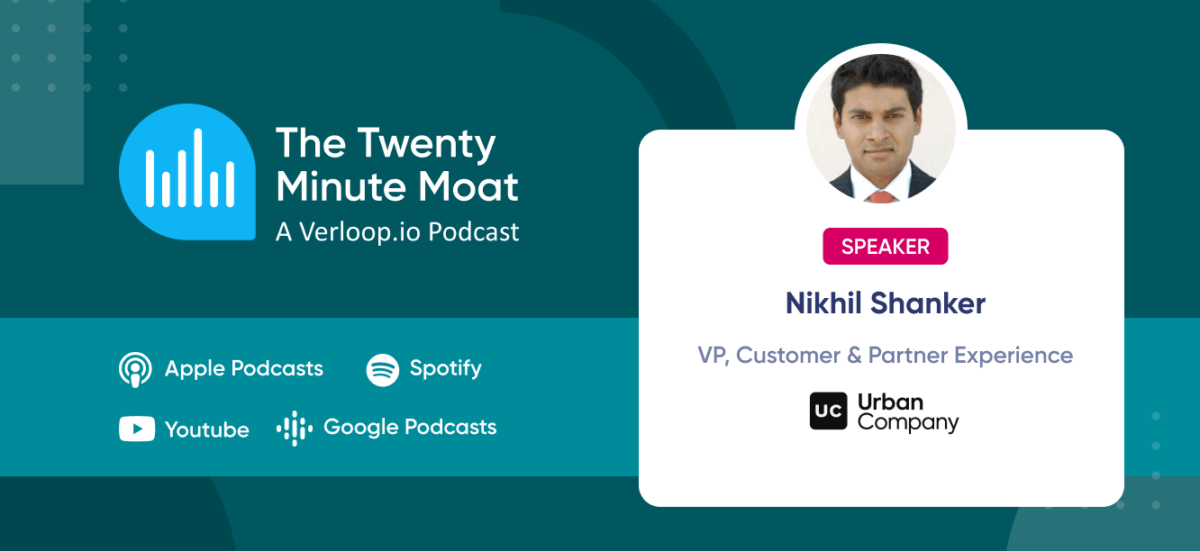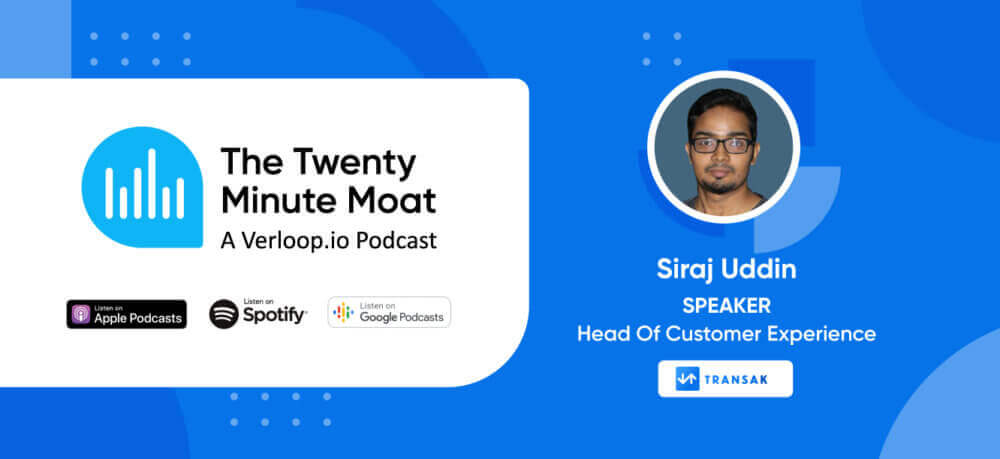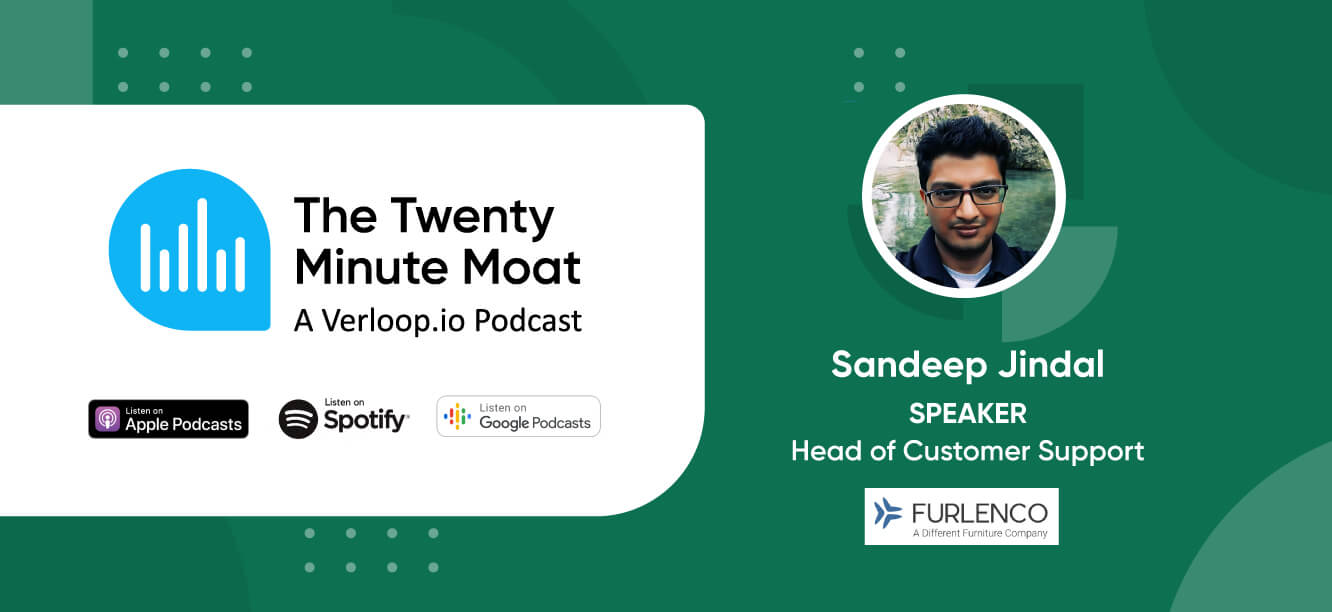Duration 19:41
Guest Speaker
Industry
Fintech
Fasih Abbas heads the Customer Success team of Cashfree and has an overall experience of 19 years managing businesses, people and growing them exponentially. He has over 10 years of CS leadership experience working with many of India’s largest e-commerce and Fintech brands.
We cover:
- Tracking the effectiveness of customer support
- How the customer support space evolved in the past year
- Best practices for delightful customer experiences
- Is there a need to reimagine customer support
Podcast Transcript
In this customer support challenges podcast part 2, we have Fasih Abbas as our podcast guest and Siddharth Sharma as our podcast host.
Siddharth Sharma
So Fasih, when we are talking about these teams, right, one of the most important metric and you… and you delve a little bit on that, was around analytics and, you know
Using data to close the feedback loop, right? So, I mean, with given your experience and your breath of the experience, right?
How do you measure effectiveness when it comes to customer support and what metrics do you generally track?
Fasih Abbas
Effectiveness is basically, you know, looking at, you know, how good you have been with your customer, right?
And did the customer actually, you know, get delighted or was he just satisfied?
Or was he not even satisfied, right?
I think that… that begins from the fact that, you know, how easy was he able to connect with us?
So the 1st and the primary metric that you would want to drive is the speed of connect or the speed of response, right?
And how soon are you able to connect to your customer the moment he says hi. The moment he wants to actually, you know dial in and he wants to speak to somebody. Or maybe he drops an email and, you know, how soon can you actually connect and start?
You know, uh… giving resolutions to it, right?
The speed of response becomes the primary question and the primary metric.
Fasih Abbas
And uh…the second most important metric would be the speed of resolution, right? While you’ve started the conversation, or while you’ve given a response, but have you actually resolved that particular customer’s issue?
And the speed of resolution then becomes the most important thing.
And the third important thing is what was the quality of interaction?
Did, you know, the end user really feel connected with you?
Did he find your response to be very insightful and, you know, solving his problem?
Siddharth Sharma
Got it.
And, you know, we have been talking about a lot of internal, focused, you know, data about team structure and analytics.
Now let’s talk about the end user, right, when it comes to the customer, right? Do you think customers are changing their mindset when it comes to customer support? Are they trying to reach brands on new different channels?
You touched upon this when you talked about social and ORM team but I knew the ORM team since quite some time back right?
So like, and you have been leading experience teams across. So what are your thoughts on this?
Fasih Abbas talks about trends
Uh, I was just, you know, carefully observing the trends in terms of, you know, how people are actually shifting from conventional channels to non conventional channels.
And, you know, self serve and automated channels, right? I think that shift Pre pandemic was anywhere between 15 to 17%, you know, slowly.
But, in the last year, year and a half, right, we’ve seen a rapid increase.
And to just quote one number which is from a very reliable source is that, you know, the usage of self serve, which was at about a 40% pre pandemic, has now moved to about a 78%, right.
So which means that, you know, a lot of the users are now coming on self serve.
Now these are… there are two reasons to it. One that, you know, definitely the… the organisations want it that way.
And they want to have leaner staff, that they want to have lesser cost.
And, you know, they want it that way and they are not providing too many conventional options but non conventional options.
Which is self serve and, you know, wanting the user to actually come through self help and then only try to connect with a human being.
Siddharth Sharma
You know we talked about teams and, you know, we talked about how the engine is? But how has this shaped up over the years?
I mean, what you are telling… what you told us right now, right, about the experience team, about the analytics team.
And about the operations team and the coaching team, right? How has this shaped up?
So how have your support teams grown and evolved in the last few years?
Fasih Abbas talks about their customer support team
Right, I think this is a very interesting question, right?
You know, what… what has happened in the support functions is earlier it used to be that uh.., most organisations felt that if you are actually available to take a call and on time and respond to a particular user.
And speaking to them very politely and then giving them a turn around time saying that, hey, I’m going to actually check with my relevant team and come back to you in the next two days.
This was actually acceptable. But now, you know, things have changed.
And, you know, consumers are also demanding and the organisations have also realised that, you know, it’s important to move.
To be faster and faster. And with this what has also happened is that now it’s about…If there is a particular query, the resolution is just given there on spot, right?
It’s about just giving instant responses (A), and (B), giving instant resolutions as well. So initially, in the survival mode where, you know, we were just taking volumes, maybe on calls or direct messages
We used to always tell them that hey, you know what
I’m going to check with my back end team and come back to you. And take about a day’s time. Go back to the back end team and, you know, fetch the right answer. Come back and tell them that hey, you know what?
You don’t qualify for this and, you know, this is the reason for it, right?
Fasih Abbas
But now what is happening is, you know, with automation the query coming in through the self serve is actually hitting a bot and the bot is actually going and fetching that information at the back end. Whether he’s eligible, he’s not eligible.
If he’s eligible for the cash back, then, you know, processing the cash back instantly and telling him that, you know, this money is going to hit his account by this time.
Uh… and if he’s not eligible, you know, state those A,B,C reasons why he’s not eligible.
Now you see the transformation, right? From a conventional set up, you know, just taking calls and being polite and trying to, you know, solve problems to giving instant resolutions.
Fasih Abbas
And I think this is the way, you know, things are transforming.
Siddharth Sharma
I’m just amazed like you know, the way customer experience has evolved, and you know, how strategic its become, right?
And, you know, and I would like to pick your brains on this one question, right?
When it comes to best practices, right, and, you know, best practices to build a delightful support experiences, what used to work before and what works now?
Fasih Abbas
OK, interesting.
I think half of it gets answered by my previous response that I gave you and I would like to add on to it.
Earlier, you know, the best practices would have been, you know, how would you actually keep moving, you know, responses, or resolutions from a L3 bucket to a L2 bucket and L2 bucket to a L1 bucket.
Fasih Abbas talks about empowering customer support
Basically empowering the very first team which is, you know, facing the customers to be able to respond and resolve those queries.
And that was the key focus. You know, how could you build better and better processes. But now, you know, it’s about, how do you ensure that you don’t need a human being, you know, to actually respond.
So there’s… there’s a very nice saying, no customer service is the best customer experience, right? So you don’t need, you know, somebody to actually solve your problem.
So I think, the way things have evolved and in the way forward, people will also realise is that, experience doesn’t start when, you know it is coming, you know, to you after this problem occurred at the customer’s end experience begins right from the first click of the customer using your product, right?
And if you get that set properly, right and I would like to quote that an organisation should work on two specific, you know, ideologies.
One, on the customer journey mapping, in terms of, you know, how does the customer feel from the first click to the time that he finishes a transaction.
And, you know, that needs to be recorded at every step. You need to have proper interventions.
You need to have proper checks and balances to see how you can keep evolving and getting better.
So you’re actually getting better on the experience part.
Fasih Abbas
And secondly, you need to also look at you know, what is your, you know, ticket journey mapping.
You know, how does your ticket actually flow within your customer experience team? What are the, you know, various touch points that you have and, you know
How could you actually you know, make it better and seamless?
How could you actually remove redundant processes and make it really, really faster and better for the end users?
I think this is… this is the key thing that I would like to mention.
Siddharth Sharma
Right. And, you know, when it comes to… you know, we talked about, you know, how customer support has been reimagined?
And you know, reshaped because of customer needs, and you know the way the brands are also growing and the way things are looking, how in your experience, is there a way to reimagine the evolution of customer support now, as of today?
Or, I mean, are we ok with the way it is going? Or do you feel that there is a need to reimagine the way?
And do you feel the pandemic was like a inflection slash turning point for organisations when it came to engaging with their customers?
Do you feel it accelerated their need to say that ok, I need to adopt something in the terms of, you know, where I can engage my customers across channel types for support?
Fasih Abbas talks about customer support channels
Yes, uh, I would strongly agree with that.
First of all, you know a lot of the conventional businesses who have been with conventional CS setups will slowly start moving into much leaner customer experience teams.
They have realised by time that, you know, this has been one of the biggest cost in the organisation. You know having bigger number of, you know, agent count and managing large setups.
This has been one of the things. And the second thing is that they also understand that, there’s a larger set of people who are using their products and services which are millennials and they would want faster responses, faster resolutions.
And they really do not want to actually, you know, stand in the queue, wait for the call to get connected and speak to somebody and… speak their heart out.
You know, the time is changing.
And, you know, a lot of people who are actually getting into this, you know, smartphone way of you know, getting responses and getting their problem solved.
So, I think this shift that is going to happen slowly.
And, I think, most organisations should start seriously thinking if they haven’t, is to move into what is more a self serve based.
You know, automation based and you know AI based, right, I think this is one key thing.
Has the pandemic actually, you know, pushed that particular you know, evolution much faster?
The answer is absolutely, yes.
I think, you know there are two significant reasons.
One, definitely because a lot of the organisations wanted to work with, you know, absolutely lower margins. And they do not want to actually, you know, run into negative profit lines.
And, you know, definitely wanted to make some money and… uh… is to reduce the cost.
And if you have to look at reducing the cost.
It means that, you know, you will have to work on cutting the edges wherever it’s possible, and specifically the customer experience teams.
Siddharth Sharma
Got it.
And I was going to ask you about, you know, how automation and conversational AI have actually enhanced, you know, have helped enhance the quality of customer support.
But I guess you have already answered that with the other question.
That, you know, how we are getting leaner and how… you know, to make it.
But, you know… I mean, if you were to… if you were to condense that, how would you say that, you know, automation and say conversational AI can actually help a brand enhance their customer support?
How would you condense that into a very short, meaningful answer for our listeners?
Fasih Abbas
Absolutely. Um… let me quote an example, right.
This… this particular instance where you know we moved a particular query type on bot automation.
Just before moving on to bot automation, the experience scores were about a 55%, right?
Just then, you know, we moved and the bot started answering these queries.
This score dropped to about a 40%, right? And… we continuously re engineered and, you know, kept working better and better on this.
And, you know, after a lot of fine tuning, lot of bot training, we were able to slowly inch up. And we were able to bring the score to a 55 in about 3 months.
And then eventually in the subsequent quarter, we moved it up to a 62%, right? Which is like fantastic, right?
Siddharth Sharma
Yes.
So it’s… it’s definitely possible, you know.
Fasih Abbas
You just need to be investing you’re right you know, time and investing on the right kind of a tool and a solution.
And you need to have a vision saying that, you know, using these reso… resources that you have, you’ll be able to move and get better on the experience side.
Siddharth Sharma
Right. And… and you talked about, you know, how having a vision with tech and having the right tools basically can help you achieve that vision, right?
Now, what is that one tech you would want in customer support today or customer experience team today?
Fasih Abbas
I think if you know, the tech can actually help me quickly summarise, you know, how good or what is the value of a particular user or a merchant in a very, very few sentences it’s as good as me telling Siddharth, you know you’ve been with our company for the last five years. and, you know, you have done so many transactions. We feel great about it and we also see that, you know, you do this kind of shopping, which we are very, very happy about and, you know. we want to continue your relationship and you are absolutely valuable.
So you are actually connecting very well with the customer.
And if you don’t then, you know, there’s a disconnect there.
Siddharth Sharma
And I can keep talking to on an on Fasih, but one last questions, right?
Fasih Abbas
Yeah
Siddharth Sharma
How do you think bots and automation in the customer support industry will, you know evolve in the coming next two to three years?
Fasih Abbas
Yeah, I think it will evolve more and more players will start using the bot automations and… that is one thing.
The second thing is, we would see that the usage of bot within any organisation who’s already started using bot automations, will significantly keep moving up.
I remember of a startup which just started with say about 5% bot automations and slowly kept inching up and at a steady state.
It was about a 60% plus of those queries actually, you know, getting done, but then, you know, moved up to about 80% bot automation. So there are two things.
One more of those, you know, organisations adopting, you know, bot automations.
2nd, the ones that have already adopted or who have started the journey will see… we will see that, you know, they are increasing the usage.
Siddharth Sharma
Right
Fasih Abbas
And definitely, you know, they would definitely look at an experience factor as the primary thing.
How better the experience is getting. Second is, you know, how better, you know, the costs are compared to the past.
And… and finally, you know, they will also try to see, you know, how analytics are coming from there.
And which can actually help the sales team boost up, you know, growth.
So I think this is how and this is what will happen in the way forward.
Siddharth Sharma
Alright, thank you so much Fasih for being with us today.
I learned a lot on this podcast, especially about, you know, what are the kind of analytics and how is the team structuring?
And, you know, how you should have a vision with the tool. You cannot just have a tool or you cannot just have a vision. They have to go hand in hand together.
Thank you so much for being there and thank you to all our listeners for listening in today.
We’ll be back shortly. And, once again, thank you so much Fasih.
Fasih Abbas
Yeah. Thanks Siddharth for having me on the session and I definitely enjoyed your questions.
And I hope the audience feels nice about listening to these responses.
Siddharth Sharma
Oh, definitely this is brilliant.
Fasih Abbas
I just want to leave you with a note that, you know, the organizsation that I work, Cashfree has seen massive growth.
We have seen about 130% growth just the previous year.
And we are with… over a one Lakh merchants strongly, you know, doing business with us.
And, you know, we are a great company and, you know, I am proud to be here and at the same time, you know, I am working on setting up, you know, the… the best ever, you know, support teams.
Siddharth Sharma
Oh. I am very bullish on Cashfree.
Fasih Abbas
Yeah, nice to hear that, yeah.
Siddharth Sharma
Alright, thank you so much.
Fasih Abbas
Thanks.



